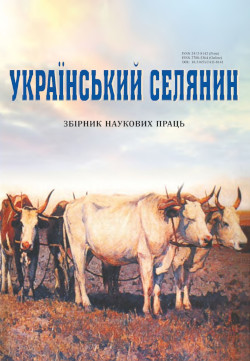Dekulakized peasant families: survival practices
Main Article Content
Abstract
Abstract. The purpose of the article is to study the main survival practices of peasant families, included in the category
of kulaks, during the implementation of the policy of dekulakization in the Ukraine in 1930 – 1931.
The scientific novelty of the research results lies in the highlighting of legal and illegal ways of rescue and survival, which
were forced to practice by dekulakized peasant families during the implementation of the policy of «liquidation of the kulaks as
a class» by the Bolshevik regime in 1930 – 1931.
Conclusion. Peasant families classified as kulaks practiced legal and illegal methods of rescue and survival during the
dekulakization of 1930 – 1931. The legal ways to avoid dekulakization and deportation for peasant families were determined
by the resolution of the Central Committee of the Communist Party of Bolsheviks of January 30, 1930, «On Measures for the
Liquidation of Kurkul Farms in Areas of Complete Collectivization», which prohibited the dekulakization of families of Red
Army soldiers and the leadership of the Red Army, and also allowed members of the kulaks family to refuse the head of the
family. Complaints of the dispossessed became another legal way of rescue, but in most cases the authorities rejected them, and
therefore the peasants could not count on the restoration of their rights. Remittances and parcels they received from relatives
helped the dispossessed to survive in the places of deportation.
Escape became the most common illegal way of rescuing «turtles». Part of the peasants began to leave immediately after
the campaign «liquidation of the kulak as a class» was announced, trying to avoid disarmament and deportation. Others began
to flee already during the deportation. The difficult conditions of existence of special resettled people led to the mass escape of
the dispossessed with their families from the places of exile. Escape was complicated by the fact that most of the deportees were
children and the elderly. Some of the fugitives settled in cities, in new buildings, where it was easy to dissolve among thousands
of manual workers, former peasants. Others, usually with fictitious documents about their social status, returned to their native
villages, demanding the return of confiscated property and land allotments from the local leadership. The rest of the fugitives
without documents moved to an illegal situation, hid in the forests or with their closest relatives.
Article Details
References
Adamovskyi, V. (2007). Deportatsii yak forma derzhavnoho teroru v Ukraini. [Deportations as a form of state terror in Ukraine]. Istoriia Ukrainy. Malovidomi imena, podii, fakty. [History of Ukraine. Little-known names, events, facts]. 34, 255–266. [in Ukrainian].
Berelovich, A. & Danilov, V. (Ed.). (2003). Sovetskaya derevnya glazami VChK–OGPU–NKVD. 1918–1939. Dokumenty i materialy: v 4 t. [Soviet village through the eyes of the Cheka–OGPU–NKVD. 1918–1939. Documents and materials: in 4 volumes]. Moskva: Rossijskaya politicheskaya
e’nciklopediya (ROSSPE’N), Vol. 3: 1930–1934; B. 1: 1930–1931. [in Russian].
Danilov, V., Manning, R. & Violy, L. (Ed.). (2000). Tragediya sovetskoj derevni. Kollektivizaciya i raskulachivanie. 1927 – 1939: dokumenty i materialy: v 5 t. [The tragedy of the Soviet village. Collectivization and dekulakization. 1927 – 1939: documents and materials: in 5 volumes]. Moskva: Rossijskaya politicheskaya e’nciklopediya (ROSSPE’N), Vol. 2. [in Russian].
Dniprenko, M. (2009). Kurkuli, svidchennia, rozdumy. [Kulaks, testimonies, reflections]. Dnipropetrovsk: Monolit. [in Ukrainian].
Ivnickij, N. (2000). Vvedenie (Razvertyvanie sploshnoj kollektivizacii). [Introduction (Deployment of complete collectivization)]. In Danilov, V., Manning, R., Violy, L. (Ed.). Tragediya sovetskoj derevni. Kollektivizaciya i raskulachivanie. 1927 – 1939: dokumenty i materialy: v 5 t. [The tragedy of the Soviet village. Collectivization and dekulakization. 1927 – 1939: documents and materials: in 5 volumes]. Moskva: Rossijskaya politicheskaya e’nciklopediya (ROSSPE’N), Vol. 2, 7–29 [in Russian].
Marochko, V. (2022). Ukrainski «kurkuli» – zhertvy bilshovytskoi polityky sotsial-shovinizmu. [Ukrainian «kulaks» are victims of the Bolshevik policy of social-chauvinism]. Ukrainskyi selianyn. [Ukrainian peasant], 27, 54–60. [in Ukrainian].
Pokrovskij, N. (Ed.). (2005). Politbyuro i krest’yanstvo: vysylka, specposelenie. 1930–1940: v 2 kn. [Politburo and the peasantry: deportation, special settlement. 1930–1940: in 2 books]. Moskva: Rossijskaya politicheskaya e’nciklopediya (ROSSPE’N), Vol. 1. [in Russian].
Shatalina, Ye. (1997). Selianski vyselky pid chas kolektyvizatsii v Ukraini (1928–1932 rr.). [Peasant settlements during collectivization in Ukraine (1928–1932)]. Kyiv: Instytut istorii Ukrainy. [in Ukrainian].
Shytiuk, M. (2001). Masovi represii na Pivdni URSR v 20-ti – na pochatku 50-kh rokiv. [Mass repressions in the South of the Ukrainian SSR in the 1920 – early 1950. Unpublished doctoral dissertation.]. Doctor’s thesis. Kyiv. [in Ukrainian].
Vasyl’iev, V. (1997). Persha khvylia sutsilnoi kolektyvizatsii i ukrainske selianstvo. [The first wave of complete collectivization and the Ukrainian peasantry]. In Vasyliev, V., Viola, L. (Сomps.). Kolektyvizatsiia i selianskyi opir na Ukraini (lystopad 1929 – berezen 1930 rr.) [Collectivization and
peasant resistance in Ukraine (November 1929 – March 1930)]. Vinnytsia: LOHOS. [in Ukrainian].
Vronska, T. (2009). Zaruchnyky totalitarnoho rezhymu: represii proty rodyn «vorohiv narodu» v Ukraini (1917–1953 rr.). [Hostages of the totalitarian regime: repression against the families of the “people’s enemies» in Ukraine (1917–1953)]. Kyiv: Instytut istorii Ukrainy. [in Ukrainian].
Vynnychenko, I. (1994). Ukraina 1920–1980-kh: deportatsii, zaslannia, vyslannia. [Ukraine in the 1920–1980: deportations, exiles, expulsions]. Kyiv: Rada [in Ukrainian].

